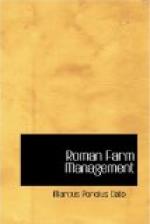Scrofa resumed: “So far as concerns the laying out of the farm, I maintain that the more appearances are considered the greater will be the profit, as, for instance, orchards should be planted in straight lines arranged in quincunxes and at a reasonable distance apart. It is a fact that, because of their unintelligent plan of planting, our ancestors made less wine and corn to the acre than we do. The point is that if each plant is set with due reference to the others they occupy less land and are less likely to screen from one another the influence of the sun and the moon and the air. This may be illustrated by an experiment: you can press a parcel of nuts with their shells on into a measure having only two thirds of the capacity of what is required to contain them after they have been cracked, because the shells keep them naturally compacted. When trees are planted in rows the sun and the moon have access to them equally from all sides, with the result that more raisins and olives are developed and then mature more quickly, a double result with the double consequence of a larger crop of must and oil and a greater profit.”
How character of soil affects agriculture
“We will now take up the second consideration in respect of the physical characteristics of a farm, namely: the quality of the soil, which partly, if not entirely, determines whether it is considered a good or a bad farm: for on this depends what crops can be planted and harvested and how they should be cultivated, as it is not possible to plant everything successfully on the same soil. For one soil is suitable for vines, another for corn, and others for other things. In the island of Crete, near Cortynia, there is said to be a plane tree which does not lose its leaves even in winter—a phenomenon due doubtless to the quality of the soil. There is another of the same kind in Cyprus, according to Theophrastus. Likewise within sight of the city of Sybaris (which is now called Thurii) stands an oak having the same characteristic. Again at Elephantine neither the vines nor the fig trees lose their leaves, something that never happens with us. For the same reason many trees bear fruit twice a year, as do the vines near the sea at Smyrna, and the apples in the fields of Consentinium. The effect of soil appears also from the fact that those plants which bear most profusely in wild places produce better fruit under cultivation. The same explanation applies to those plants which cannot live except in a marshy place, or indeed in the very water: they are even nice about the kind of water, some grow in ponds like the reeds at Reate, others in streams like the alders in Epirus, some even in the sea like the palms and the squills of which Theophrastus writes. When I was in the army, I saw in Transalpine Gaul, near the Rhine, lands where neither the vine, nor the olive, nor the pear tree grew, where they manured their fields with a white chalk which they dug out of the ground:[62] where they had no salt, either mineral or marine, but used in place of it the salty ashes obtained from burning a certain kind of wood.”




